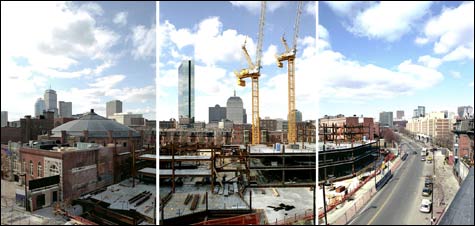
ATELIER 505 CONSTRUCTION SITE: Mori Insinger documents the construction of a luxury condo and theater building in the South End.
|
Toronto photographer Edward Burtynsky spent the 1980s and ’90s roaming North America, photographing strip mines, quarries, oil fields, trash heaps, and junk bundled for recycling. Around 2000, his obsession with humanity’s industrial exploitation of our landscape and natural resources brought him to China.
In “The China Series,” which was organized by North Carolina’s Southeastern Center for Contemporary Art and is on view at the Tufts University Art Gallery through April 1, Burtynsky presents 20 photographs of a nation buzzing with construction and manufacturing and growth. Thousands of brightly attired factory workers course down a factory street at a shift change. A river of plastic toys waits to be recycled. Ladies toil at endless rows of machine looms. Workers construct shoes as trays blur by them on an assembly line. Sparkling futuristic apartment towers rise at the edge of a warren of old streets crowded with buildings as part of “urban renewal” projects.
The standout photo here is Manufacturing #17, Deda Chicken Processing Plant, Dehui City, Jilin Province (2005). Thousands of factory workers in pink raincoats, blue aprons, and white masks and boots stand at row after row of long tables cutting up chickens in red tubs. The people seem cooped up, but the pattern of the bright colors of their outfits, seemingly repeating to infinity, gives the image a cheery tone, as if it were some odd musical — maybe a more upbeat, cast-of-thousands version of the Björk-starring Dancer in the Dark.
“China is the most recent participant to be seduced by Western ideals — the hollow promise of fulfillment and happiness through material gain,” Burtynsky wrote in his 2005 photo book China. “The mass consumerism these ideals ignite and the resulting degradation of our environment intrinsic to the process of making things should be a deep concern to all.”
Burtynsky’s scenes, however, don’t exactly fill me with concern. Instead I’m dazzled by the ravishing kaleidoscopic patterns, the romantic lighting, the vast scale, and the profusion of detail captured on his large-format film. The 51-year-old often shoots from far away and high above, like a god watching impassively from the heavens. The world may be going to shit, but isn’t it pretty?
Manufacturing #4, Factory Worker Dormitory, Dongguan, Guangdong Province (2005) depicts a strangely vacant six-story white and pink apartment complex standing next to a canal. Burtynsky shoots the building head on, and what’s striking is the repeating grid of the balconies, each one with matching pink and blue wardrobes hanging on clothes lines. It’s evidence of people dwarfed, turned into uniform cogs in the machine of gargantuan Communist industry. Burtynsky offers glimpses of the rising New China that we hear much about these days, the Asian juggernaut that’s competing with us for water, petroleum, and other natural resources. But ultimately these photos are about an elegant formalism, a reinvention of the minimalist grid, that muffles documentary or social concerns.
In Burtynsky’s work, you find echoes of Donald Judd’s fascination with repeating industrial forms and Robert Smithson’s earthworks. And there’s a direct line to Margaret Bourke-White’s photos of American industry in the 1920s and ’30s, like the shot of Fort Peck Dam in Montana that graced the cover of the first issue of Life magazine in 1936. (Has industry ever looked more classical and sexy?)
Burtynsky favors a rigid geometry — he faces his subjects straight on, often with vanishing points right at the center of his viewfinder, or turns them at angles running from one corner of his frame to another. Many compositions are symmetrical or mirrored. Sometimes this formalizing eye can feel dull and repetitive, as in the photographs of dying Chinese factories that he exhibited at Boston’s Barbara Krakow Gallery last September, in which all lines ran back to the center of the image like bull’s eyes. Who needs more elegant formalist industrial rot porn? But I’m wowed by the dazzling patterns and the awesome scale here. The chicken-processing plant and shoe-sweatshop photos seem like prequels to German artist Andreas Gursky’s iconic 1999 photo 99 Cent, a head-on panorama of an LA discount store, aisle after aisle filled with a dazzling profusion of candy, cookies, drinks, pantyhose — the cheap American capitalist cornucopia.
As Burtynsky’s previous work documents, none of this society-and-industry-versus-nature stuff is particular to China, except for the cool color scheme and the super-sized scale. New England was built on mills. We trumpeted our vast constructions — skyscrapers, dams, bridges — and our manufacturing might during the mid 20th century. Massachusetts’s 39-square-mile Quabbin Reservoir was created in the 1930s by drowning four towns. And we still express our ambition and pride in the scale of our constructions and engineering feats — from the Big Dig to Mayor Menino’s proposed thousand-foot-tall office tower (“We’ll be looking for proposals that symbolize the full scope of this city’s greatness”) to the cantilevered top floor of the new Institute of Contemporary Art. Burtynsky writes, “The troubling downside of this is something I am only too aware of from my experience of life in a developed nation.”